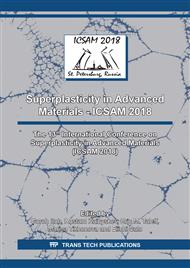p.349
p.355
p.359
p.364
p.373
p.379
p.385
p.391
p.397
Solution Treatment Process of Haynes 230 Cylindrical Blank Used for Hot Flow Spinning
Abstract:
Hot flow spinning is one of the most effective methods to manufacture the cylindrical parts of nickel-based superalloy. However, crack occurs easily in the hot flow spinning process of Haynes230 alloy when the cylindrical blanks are obtained by forging and wire-electrode cutting billet due to the severe segregation of carbides existed in the microstructure of the Haynes230 forging billet. The solution treatment process of Haynes230 blank is put forward to obtain the cylindrical blank with homogeneous and fine grained microstructure used for hot flow spinning. The influence of solution treatment process on the microstructure and hardness of Haynes 230 was investigated; and the relationship between grain size and solution temperature was analyzed. The results show that the grain size of Haynes230 alloy increases with the increasing of solution temperature and the holding time. The abnormal growth of grains occurs under excessively high solution temperature and long holding time. The grain growth activation energy of Haynes230 is about 296.0kJ/mol. The hardness of Haynes230 alloy decreases with the increasing of solution temperature, but negligibly changes with the holding time. The severe segregation of carbides can be eliminated and the cylindrical blank with homogeneous and fine grained microstructure used for hot flow spinning of Haynes230 alloy can be obtained after solution treatment at 1230°C for 60 min heat preservation.
Info:
Periodical:
Pages:
373-378
Citation:
Online since:
July 2018
Authors:
Price:
Сopyright:
© 2018 Trans Tech Publications Ltd. All Rights Reserved
Share:
Citation:



